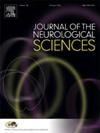Association of paramagnetic rim lesions with patient-reported neuropsychiatric symptoms in multiple sclerosis
IF 3.2
3区 医学
Q1 CLINICAL NEUROLOGY
引用次数: 0
Abstract
Background
Paramagnetic rim lesions (PRLs) mark chronic active lesions in multiple sclerosis (MS) and have been linked to disability progression and objective cognitive decline, but their relationship with invisible symptoms such as fatigue, mood disturbance and perceived cognition remains unclear.
Methods
We prospectively enrolled adults with MS who underwent 3T susceptibility-weighted imaging. Supratentorial PRLs were counted and participants were categorised into 0, 1–3 or > 3 PRLs. Neuro-QoL T-scores for fatigue, depression, anxiety and perceived cognition were collected at baseline and annually for up to five years (median 3.1 years, 419 person-visits). Cross-sectional associations were examined with multivariable linear regression; longitudinal change was modelled with linear mixed-effects models adjusted for age, sex, race and MS course, applying false-discovery-rate correction.
Results
Among 92 adults with MS (mean age 51 ± 13 years; 78 % women), 41 participants (45 %) had no PRLs, 27 (29 %) had 1–3, and 24 (26 %) had > 3. At baseline, PRL burden did not correlate with fatigue, depression, anxiety, or cognition (all FDR-adjusted p > 0.70). During follow-up, PRL category did not influence trajectories of fatigue, depression, or cognition. Participants with >3 PRLs experienced a modest annual reduction in anxiety (−1.8 T-score points/year; 95 % CI -3.05 to −0.56; FDR p = 0.02).
Conclusions
Supratentorial PRL burden is not a major determinant of common invisible symptoms in MS. The unexpected inverse association with anxiety may in part reflect regression to the mean or adaptive coping over time and needs replication in larger cohorts incorporating lesion volume, location, and treatment exposure.
多发性硬化症中顺磁边缘病变与患者报告的神经精神症状的关系
顺磁边缘病变(prl)标志着多发性硬化症(MS)的慢性活动性病变,与残疾进展和客观认知能力下降有关,但与疲劳、情绪障碍和感知认知等无形症状的关系尚不清楚。方法前瞻性招募接受3T敏感性加权成像的成年MS患者。计算幕上prl,并将参与者分为0、1-3或3个prl。在基线和每年收集疲劳、抑郁、焦虑和感知认知的神经质量t评分,持续5年(中位数为3.1年,419人就诊)。采用多变量线性回归检验横截面相关性;纵向变化采用线性混合效应模型进行建模,校正了年龄、性别、种族和多发性硬化症病程,并应用错误发现率校正。结果92例成年MS患者(平均年龄51±13岁,78%为女性),41例(45%)无prl, 27例(29%)有1-3,24例(26%)有>; 3。在基线时,PRL负担与疲劳、抑郁、焦虑或认知无关(所有fdr校正p >; 0.70)。在随访期间,PRL类别不影响疲劳、抑郁或认知的轨迹。3个prl的参与者每年的焦虑程度适度降低(- 1.8 t评分/年;95% CI -3.05至- 0.56;FDR p = 0.02)。结论:幕上PRL负担不是ms常见隐性症状的主要决定因素,与焦虑的意外负相关可能部分反映了随着时间的推移回归到平均水平或适应性应对,需要在包含病变体积、位置和治疗暴露的更大队列中进行验证。
本文章由计算机程序翻译,如有差异,请以英文原文为准。
求助全文
约1分钟内获得全文
求助全文
来源期刊

Journal of the Neurological Sciences
医学-临床神经学
CiteScore
7.60
自引率
2.30%
发文量
313
审稿时长
22 days
期刊介绍:
The Journal of the Neurological Sciences provides a medium for the prompt publication of original articles in neurology and neuroscience from around the world. JNS places special emphasis on articles that: 1) provide guidance to clinicians around the world (Best Practices, Global Neurology); 2) report cutting-edge science related to neurology (Basic and Translational Sciences); 3) educate readers about relevant and practical clinical outcomes in neurology (Outcomes Research); and 4) summarize or editorialize the current state of the literature (Reviews, Commentaries, and Editorials).
JNS accepts most types of manuscripts for consideration including original research papers, short communications, reviews, book reviews, letters to the Editor, opinions and editorials. Topics considered will be from neurology-related fields that are of interest to practicing physicians around the world. Examples include neuromuscular diseases, demyelination, atrophies, dementia, neoplasms, infections, epilepsies, disturbances of consciousness, stroke and cerebral circulation, growth and development, plasticity and intermediary metabolism.
 求助内容:
求助内容: 应助结果提醒方式:
应助结果提醒方式:


